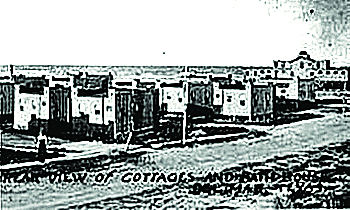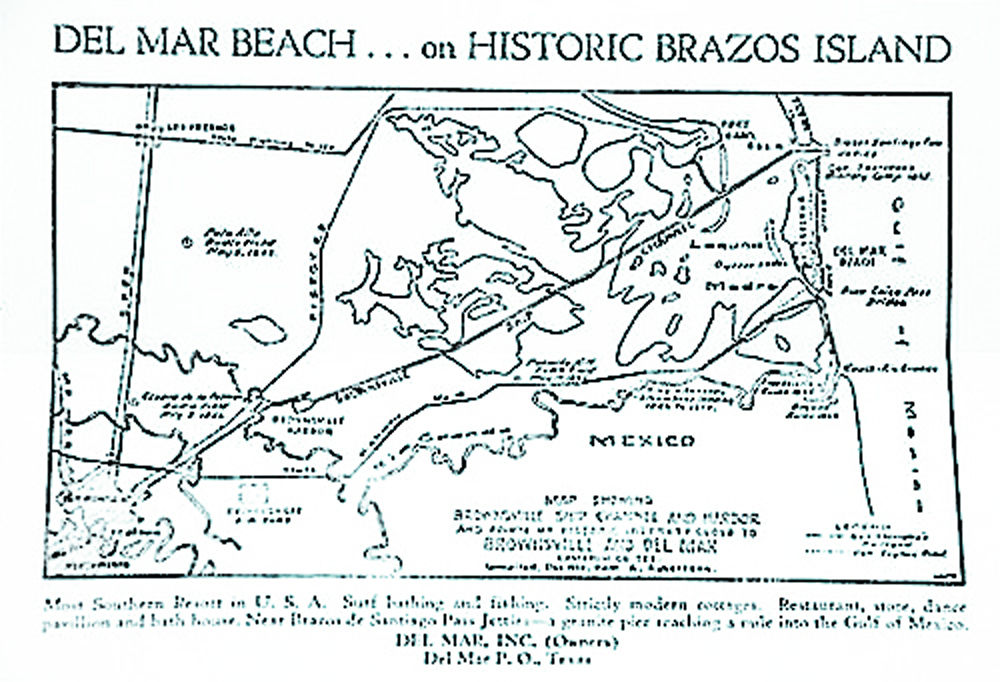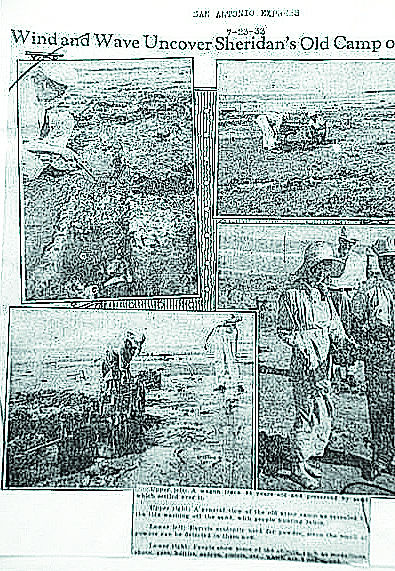BY NORMAN ROZEFF
EDITOR’S NOTE: This is the next installment in an ongoing series on San Benito’s Sam Robertson. Find previous parts at www.ValleyStar.com.
In 1930 Colonel Sam received Brazos Island, located at the mouth of the Rio Grande River, and the Boca Chica toll bridge as payment for a debt. He devoted the remainder of his life to the development of his seaside resort, Del Mar.
The two 1933 hurricanes greatly damaged this Robertson project, one that had advanced more than the Ocean Beach Driveway. His Del Mar beach resort was on the south end of Brazos Island. Here he had constructed 31 modern cottages, a bath house, a restaurant, and a hotel building named the “Surfside.”
August 1931 saw a channel opened from Del Mar to the Laguna Madre. Some thoughts were to dredge a channel from Del Mar to Brownsville, but this never came to pass. By February 22,1922, however, a road from Brownsville to Del Mar had been completed. On 10/12/32 the telephone line that took the Rio Grande Valley Telephone Company 35 days to erect reached the Del Mar project.
When the resort reopened in April 1934 there were 26 new cottages advertised as having the latest amenities “including private shower and bath, and a telephone in every room.” These were constructed more sturdily than the previous ones and were bolted to a deeper foundation as well as having re-enforced walls and roofs. Years later some of the cottages were eventually moved to Harlingen where they were transformed into cabins for a motor court on South F Street. They are there to this day.
A new restaurant and dance hall were also built and the old bathhouse repaired.
While Maria, Sam and family friends, Mr. & Mrs. Neil Hanson and Mr. & Mrs. Henry Hicks rode out the first storm at the resort, Sam and Maria were fortunate that they decided to go inland when the Labor Day Storm of 1933 hit the area with wind gusts up to 125 miles per hour.
By April 7, 1934 the Robertsons reopened after repairs and the addition of an asphalt road and toll bridge from the Boca Chica Pass to the resort.
The storm did have one positive impact. The storm surges that drove waves across Brazos Island uncovered numerous Union Civil War artifacts, especially at the very north end where the Union Army had established a depot at Brazos Santiago. Col. Sam was to collect many artifacts from the sands turned up by the waves.
This piqued his interest in the Civil War, a war that had devastated his father’s life and that of his grandfather. He went on to collect stories and documents from old local residents. These included an 1867 map of the island. He donated this to Port Isabel’s Harbart Davenport, the local historian who was also a founding member of the Texas Historical Society. Davenport, in turn, presented it to Lota M. Spell of the Advisory Board of Texas Historians. Lota Mae Spell was the first director/curator of the Nettie Lee Latin American Collection.
The resort had opened with considerable fanfare with family friends and newspaper people attending the event. Another promotion in April 1933 ended in tragedy. During a skydiving exhibition, the parachute of William G. Swan failed to open and he fell to his death over open water. Continuing to lure guests to the resort the Robertsons, as Thompson relates, continued various promotions. One was
“October 1, 1934 (when) Sam and Maria promoted a fishing tournament for Red Fish, Trout, and Catan. Paul Usher won most trout for a day (28) winning $2.50, Librado Perez won largest red fish (19 ¼ lbs.) winning $5.00 prize money, and C.A. Pinkley won longest catan, winning ($1.00 ) prize money. August 25, 1937 (brought) a crowd of 3,250 visitors and on April 25,1938 (the resort) had 1,650 visitors. (On) May 13,1938 they again promoted ‘Cottages, Casino action, and Redfish competition at the Del Mar Beach Resort’.”
It was this same year that the Brownsville Herald featured an article on a happy Robertson family reunion.
The article announced “FOUR ROBERTSON BROTHERS REJOINED AFTER 42 YEARS. San Benito — The fourth of July saw the first reunion of Frank and Sam Robertson, prominent Valley men, and their two brothers since 1896, 42 years ago. W.W. and Robert E. Robertson of Missouri arrived in the valley Monday afternoon. The former is an engineer and Baptist minister residing in Caroline Mo. Robert Robertson is in the insurance business at Kansas City. The Missouri brothers visited Del Mar Beach Resort where Col. Sam Robertson is head of the states most popular beaches. The four brothers went into the construction work during their youth and all but Robert have continued in that endeavor to the present time. Col. Sam Robertson constructed several pioneer railroads in the Valley. His brothers Frank and W.W. were affiliated with him at that time. Frank is prominently recognized as the pioneer in Valley irrigation. The younger brother Robert assisted in the construction of a railway in Missouri, but for the past 24 years has been out of the construction business.” At the time a newspaper article, datelined San Benito, on the same subject noted that Col. Sam’s brother Frank had been superintendent of construction on the San Benito Drainage District, had been manager of the Cameron County Irrigation District #2 since 1930, had pushed for Valley water resources development for 22 years, was one of the founders of the Valley Baptist Hospital of Harlingen and for the last 13 years had been its president. In his own words Sam was to tell the story of his last two ventures. He wrote: “ I organized the Ocean Side Toll Road Company and acquired a strip of right of way 200 feet wide on the beach between high and low tide from the mouth of the Rio Grande to Aransas Pass. But our attorneys told us that our right of way on this island acquired from the State of Texas was no good as the state never owned it. Bill Callahan and myself bought out Pat Dunn about 50,000 acres on the island. In straightening out the title we got over 10,000 acres more which neither Dunn nor ourselves knew anything about. The King estate and Kenedy gave us right of way over their property on Brazos and Padre Islands, and of course when we got the Dunn property, the right of way for the toll road went with it.
We built the toll bridge we now own over Boca Chica Pass (1938), operated ferry service from Point Isabel to Padre Island and Brazos Island, built a through bridge across Corpus Christi Pass between Mustang Island and Padre Island, leased the junk railroad running from Aransas Pass to Harbor Island, built low flat cars using railroad push cars with flanged wheels. We ran the automobiles through troughs up to our little flat cars. Each flat car carried three autos. We used a Ford truck with flanged wheels for a locomotive. We also built a telephone line the length of the island.
We crossed many sand drifts on wire mesh reinforced with asphaltum. This we picked up on the beach, and lastly we built Don Patricio Causeway, a double track through bridge 16,500 feet long across Laguna Madre from the north tip of Padre Island to the main land near Flour Bluff, 17 miles east of Corpus Christi. Don Patricio Causeway was destroyed by the 1933 hurricane.
After about one year of operation of the toll road, causeway, ferries, etc. we found the drift sands, high tides, etc. made the whole enterprise a gold brick. Under the influence of the Florida boom, we unloaded it all on the Jones Brothers of Kansas City at a nice profit. The Jones Brothers were millionaires and sunk a fortune on the scheme. After the 1929 crash they gave me back their interest in Brazos Island for a $6,000 credit on one of their notes that I held. The insurance premium on the causeway these “birds” are talking about building will cost them over $60,000 annually. They are just talking through their hats –1938.”
As a side note, it was said that the labor involved in these projects were the dregs of humanity, derelicts and dopeheads. Colonel Sam sought to rescue these poor souls with gainful employment and hard work. He had a strong love for the underdog. This action was nothing new, for Sam “was respected for always being fair and for his readiness to help any man willing to work. Negroes, hobos and boys on their own for the first time worked alongside work toughened camp hands who had followed him from job to job”, this being earlier on the Robstown-Brownsville railroad construction.
That Robertson’s vision had merit is validated in the great activity that we see today on the island near Corpus and on South Padre Island. In addition, Congress established Padre Island National Seashore and President John F. Kennedy signed the bill into law on September 28, 1962.






